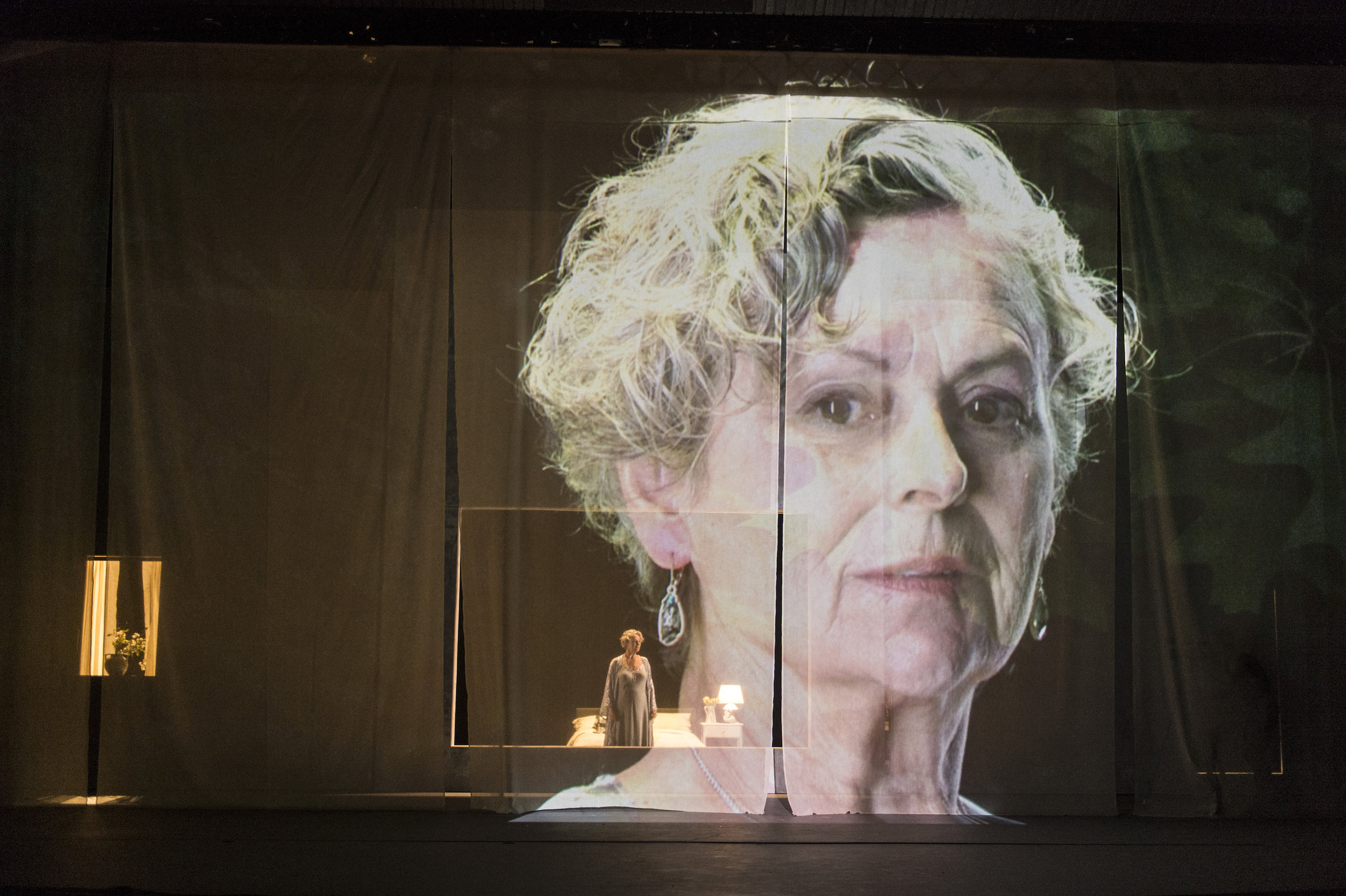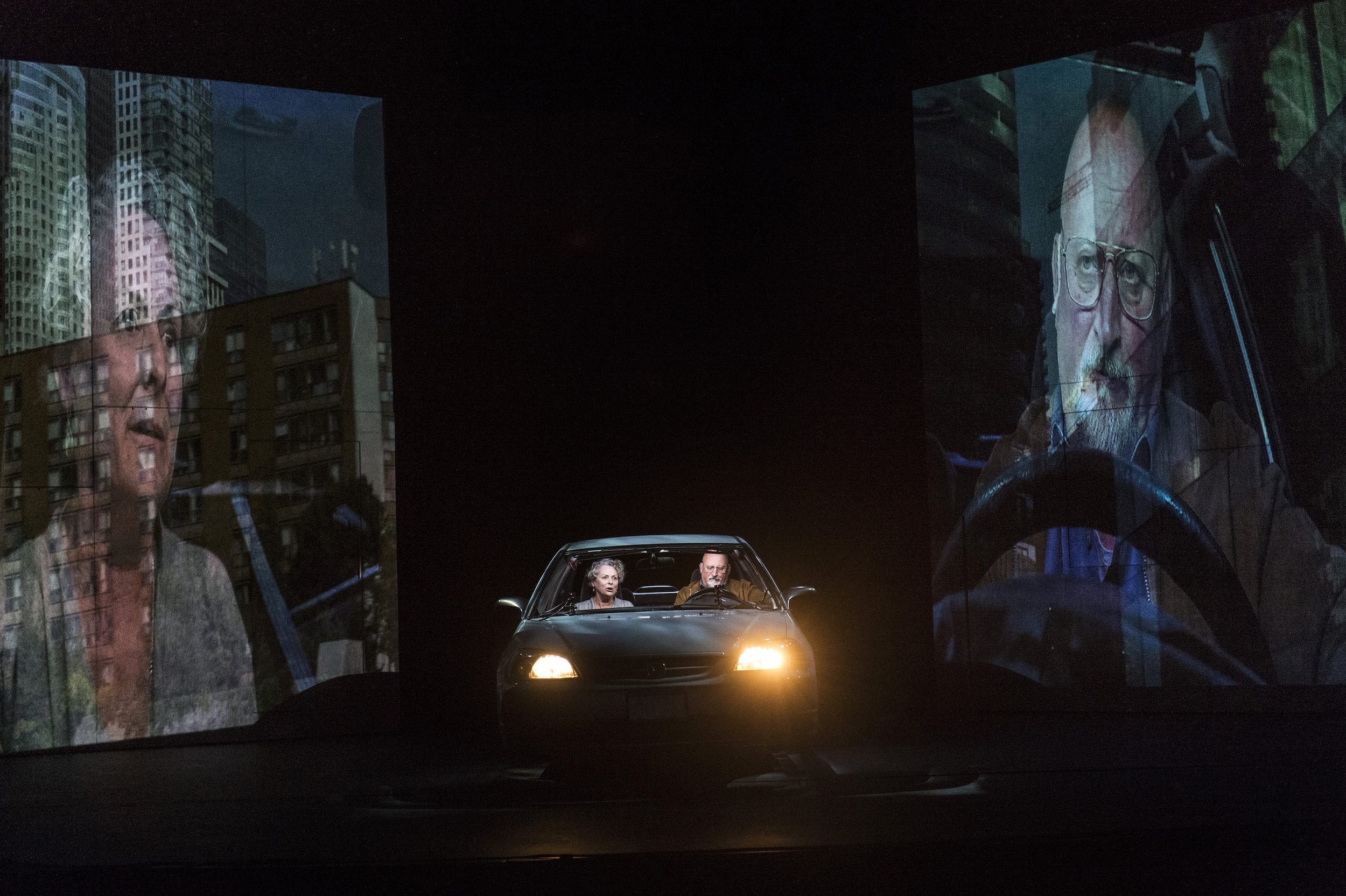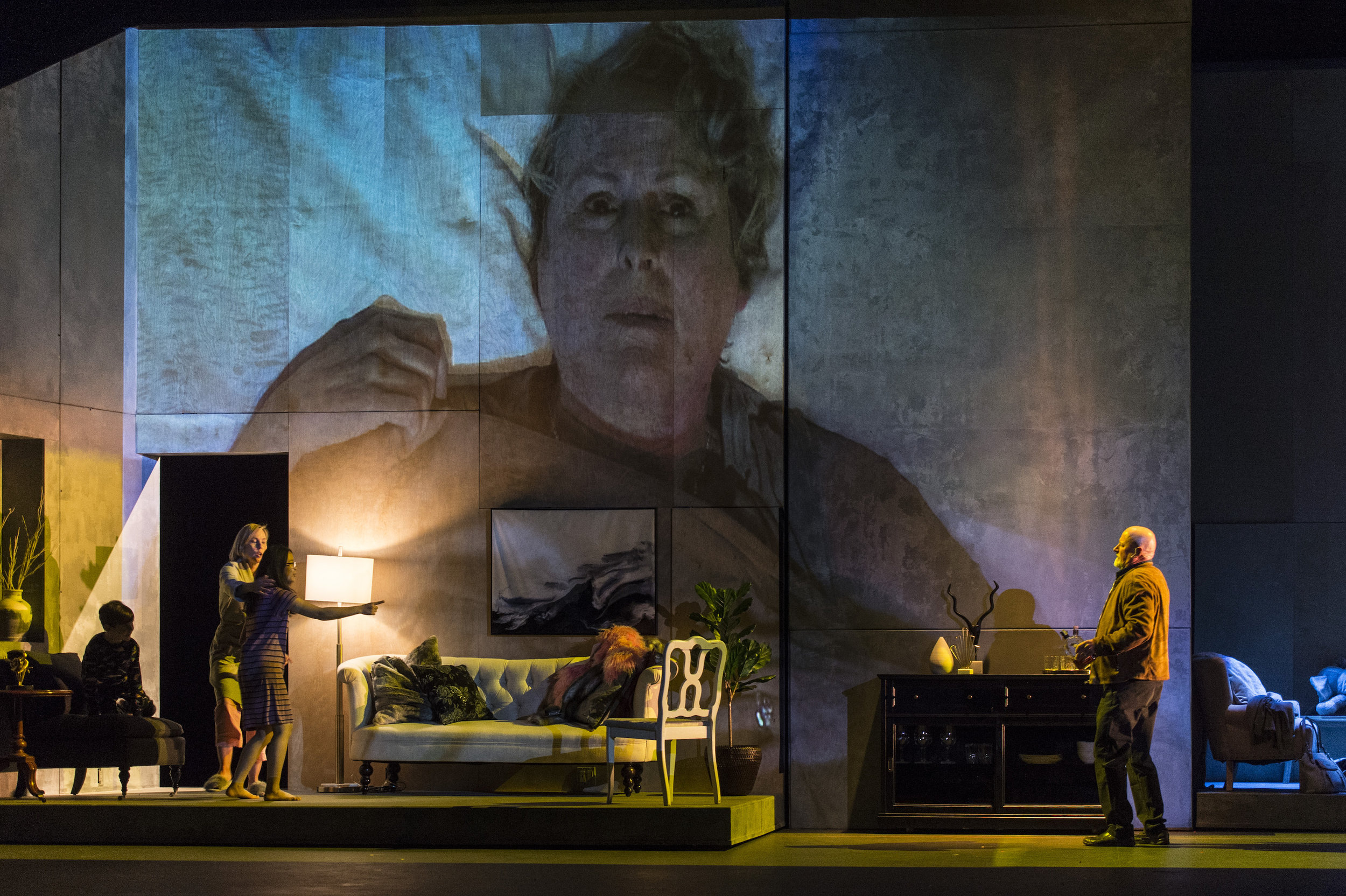Electric Company Theatre’ latest work, The Full Light of Day, stretches the possibilities of theatrical storytelling, skillfully incorporating videography. The two-act play uses both live streaming, as well as pre-recorded video footage, to tell its story. Combined with stunning set, lighting, and costume designs, The Full Light of Day is quite a visual treat. With the use of Brian Lind’s movie-like sound design, the show indeed verges on creating a new art form – a theatre/film hybrid. Unfortunately, the show lacks a strong enough story to support its tremendous production values.
The show’s publicity materials promise a suspenseful and compelling story of a terminally ill woman who confronts the choices that brought her family privilege, all told against the backdrop of the real estate industry. While this sounds intriguing and timely, in reality the show’s story is definitely not suspenseful or compelling – nor does it truly dive in to the real estate story angle that it promotes. Despite all the hype promising excitement and high drama, the show comes across as the laments of a senior citizen from a very specific demographic, and the majority of audiences will likely not be able to relate.
The issue is that the exciting elements of the story – the implied backstabbing and mob-like events within the real estate industry, are never really addressed or explained. Not only did this leave me disappointed, but also annoyed because this two-and-a-half-hour play seems to drag on, and I never really got a clear understanding of the scandal that supposedly serves as the backbone of the story.
Dean Paul Gibson and the ensemble of The Full Light of Day - photo by Don Lee
And despite the show’s publicity material proclaiming it as a “thriller”, it’s really a bit of a snoozefest. The majority of the story focuses on the last few days of Mary as she nears death and tries to redeem herself for overlooking the scandalous real estate dealings of her husband, Harold. While her naivety annoyed me, I didn’t completely dislike Mary – which can’t be said for all the rest of the characters in the show. Harold and the eldest son David, are complete douchebags, the daughter Jane is pretty unlikeable for most of the show, until perhaps near the end. And the youngest son Joey is a complete idiot. David’s wife, Sherry, is also unbearably annoying as well.
Gabrielle Rose in The Full Light of Day - photo by Don Lee
There were basically no characters that I cared for or could relate to. And I definitely couldn’t relate to the story. The thing is, even when audiences can’t relate to the primary storyline, they should be able to at least relate to some of the subplots. And for some reason, there are literally no real subplots in this story.
There’s a tiny subplot surrounding Jane not being able to get on with her life following the death of her husband. But that’s never really expanded on. The lack of subplots in this play is actually ironic, since the first act does try to be a little adventurous, dividing itself into a few different segments. Each tells the events of the same day from a different character’s point of view. But despite this, the story is one, barely interesting, linear story with no surprises.
Gabrielle Rose and Jim Mezon in The Full Light of Day - photo by Don Lee
I did enjoy the efforts of Gabrielle Rose as Mary, as she really throws herself into her character, which isn’t an easy task considering how much she goes through. The naivety of her character as written in the script annoyed me – but Rose herself did not. She does an outstanding job coming across as genuine and tells her character’s story well. The entire cast for that matter does a great job of bringing their characters to life – it’s just that none of these characters are likeable or have anything interesting to offer.
What I find quite puzzling is the fact that there are four ensemble actors, who each play a variety of small, silent roles throughout the show. Yet some of the principal characters play multiple speaking roles, to the point where it’s sometimes confusing as to whether or not they’re playing their primary character or a side character. It’s mysterious as to why the ensemble actors are so underutilized. I’m still confused as to whether the character of Joey is also a church reverend, since Jonathon Young clearly plays both.
The cast of The Full Light of Day - photo by Don Lee
Also unsettling is a seemingly unnecessary scene at a poolside party, where Harold has a strange conversation with a character played by the same actress (Jenny Young) who plays his daughter, Jane. Not only does this make it confusing as to whether he’s at first speaking to Jane, but their almost flirtatious conversation feels uncomfortable.
Writer Daniel Brook’s dialogue often comes across as unauthentic as well. For example, while living his best douchebag life at restaurant, David suddenly proclaims himself as a fan of American musical theatre and starts to belt out “Oklahoma!”, which seems highly unrealistic given his character. And there’s a scene where David’s ten-year-old daughter Lorna, threatens her dad by saying something to the effect of how she’s going to cut her dad up into little pieces and serve him as cocktail hors d'oeuvres. This seemed very weird and unsettling.
What I did enjoy about the play is the sweeping, cinematic effect it creates with the use of Kevin Kerr’s video work, and the stellar visual production elements, thanks to Julie Fox’s set designs and Michael Walton’s lighting designs. Take for example, the scene where Joey speeds off in his car through the streets of Toronto. Yes, there’s an actual car onstage – but it’s the video work and lighting used that creates the exciting effect of this scene.
Kerr’s video work, which often involves live streaming projected onstage in a larger-than-life scale, is also excellent in that it offers us close-ups of the actors - thus providing us with different visual perspectives of what’s going on.
Director Kim Collier must be given kudos for weaving together the creative visual elements of the show. And Nancy Bryant’s stylish contemporary costume designs complete the gorgeous visuals.
Jillian Fargey, Jim Mezon, and Jenny Young in The Full Light of Day - photo by Don Lee
The large set panels onstage prove to be quite useful throughout the show, whether they’re rotated backwards to create projection screens for the video work, or facing towards the audience to create the beautiful home of David and Sherry, letting us see into different rooms. Utilizing the entirety of the Playhouse stage, complete with set pieces flying in from above, the visual effect parallels that of a grand opera.
If only there was a grand story or likeable characters to match these delicious visuals. The show’s message - that the value of real estate, and the scandalous dealings with the industry, has shaped a hierarchical class system where some live extraordinary wealthy lives, and others suffer in poverty - never really comes through. This is because the story is bland and unrelatable, and the characters are unlikeable and uninteresting. No amount of visual spectacle can make up for this.
The Electric Company Theatre, in association with Banff Centre for Arts and Creativity, and BMO, presents The Full Light of Day, running until January 12 at the Vancouver Playhouse. For more information, visit the Electric Company Theatre’s website.



